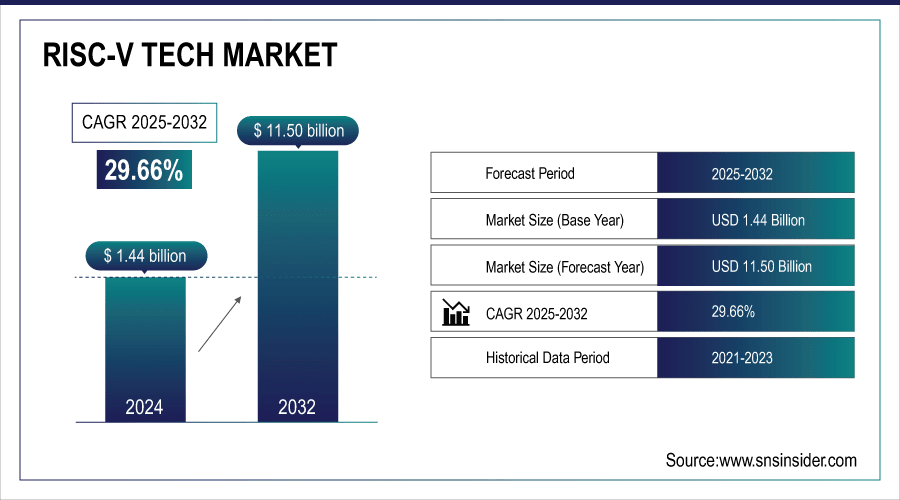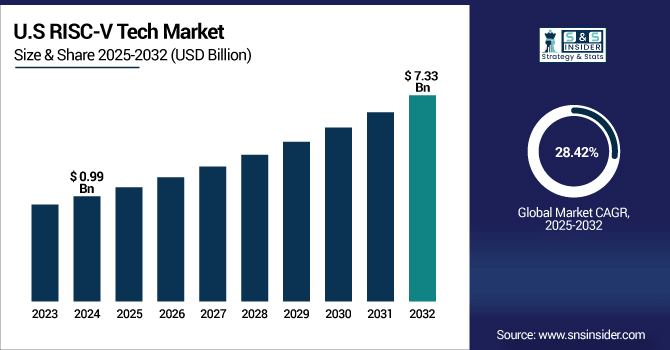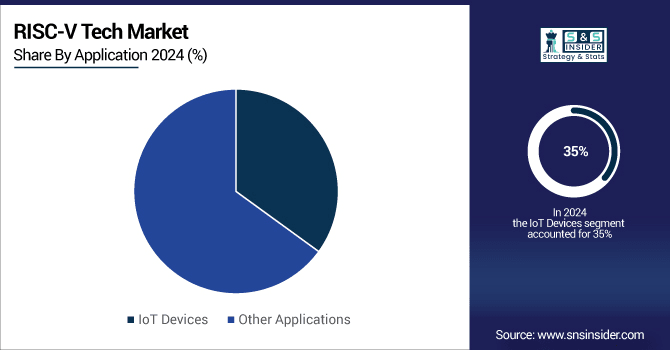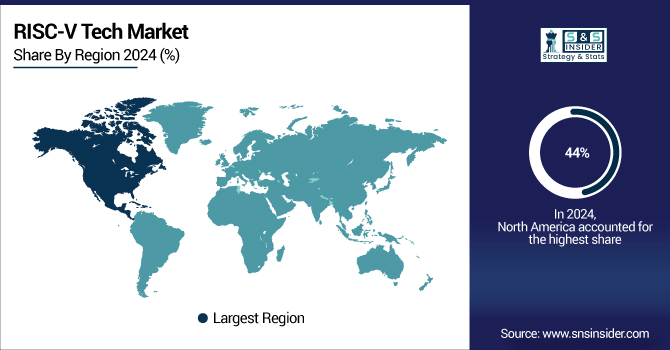RISC-V Tech Market Size & Trends:
The RISC-V Tech Market Size was valued at 1.44 Billion in 2024 and is projected to reach USD 11.50 Billion by 2032, growing at a CAGR of 29.66% from 2025 to 2032.
The RISC-V market is experiencing rapid growth, driven by its widespread adoption across industries such as blockchain, AI, IoT, and semiconductor design. Significant advancements, like DeFacto's automation for SoC integration and innovations in 2D semiconductor technologies, are enhancing RISC-V's performance. This progress is further accelerated by contributions from industry players, promoting the global use of RISC-V-based chips in consumer electronics and embedded systems. In India, experts highlight the need to intensify research into alternative materials and new form factors to reduce dependency on traditional silicon
Following China's breakthrough in creating a one-nanometer RISC-V chip. Meanwhile, Vitalik Buterin's RISC-V proposal is gaining traction within the Ethereum community as a solution to scalability but raises concerns about backward compatibility. Ethereum is also facing financial pressure, with transaction fees dropping significantly due to the rise of cheaper layer-2 solutions like Arbitrum and Optimism, causing a 95% drop in blob fees, which may affect the network's future viability.

To Get More Information On RISC-V Tech Market - Request Free Sample Report
The U.S. RISC-V Tech Market, expected to grow from USD 0.99 billion in 2024 to USD 7.33 billion by 2032 WITH CAGR 28.42%, is being driven by advancements in open-source architecture, which aligns with global trends in semiconductor innovation.

2D materials, with their ultra-thin structure, hold great promise for creating denser, more efficient, and cost-effective chips. These materials are useful for integrated circuits, displays, and various electronics applications. Chinese researchers Wenzhong Bao and Peng Zhou detailed the creation of a sub-one-nanometer-thick chip called Wuji, built using 5,900 molybdenum disulfide transistors. This innovation follows the U.S. government's restriction on ASML's EUV lithography export to China. For India, RISC-V’s open-source architecture presents an opportunity to avoid licensing costs and geopolitical risks associated with ARM or x86.
RISC-V Technology Market Dynamics:
Drivers:
-
Growing Demand for Open-Source Chip Architectures Fuels RISC-V Market Growth
The global shift towards open-source chip architectures like RISC-V is driven by the need to reduce reliance on proprietary instruction sets like x86 and ARM. An example of this is China’s Jiachen Project, which incentivizes the hacking of AMD’s Zen CPUs to run RISC-V binaries, highlighting the demand for customizable, license-free processors. Although experts question the feasibility due to the limitations of x86 microcode, the push for open-source alternatives is growing. Governments and businesses are prioritizing architectural independence, cost reduction, and innovation flexibility, making RISC-V a critical factor in developing resilient, future-proof semiconductor ecosystems.
Google's Zentool exposes vulnerabilities in AMD’s Zen microcode, prompting China’s Jiachen Project to offer ¥20,000 for hacking Zen CPUs to run RISC-V binaries. While experts doubt its feasibility due to hardwired x86 limitations, the effort highlights global interest in open-source alternatives. Critics view the challenge as impractical, potentially suited more for state-backed labs than independent developers.
Restraints:
-
Limited hardware support for RISC-V, compared to ARM and x86, restricts its scalability and hinders broader market adoption.
Limited hardware availability is a significant restraint for the RISC-V tech market. Unlike established architectures like ARM and x86, which have extensive support across a wide range of devices, RISC-V is still developing its hardware ecosystem. This limitation reduces its scalability and potential adoption in various industries, particularly in high-performance computing and consumer electronics. The availability of RISC-V-based processors and compatible components is constrained, with fewer options for manufacturers .Consequently, companies seeking to implement RISC-V solutions face challenges in sourcing reliable hardware and ensuring compatibility with existing systems. Until hardware availability increases and more vendors integrate RISC-V support, its widespread adoption will likely remain restricted.
Opportunities:
-
RISC-V Market Opportunity in AI and Machine Learning Applications with Customizable, High-Performance Solutions
RISC-V is gaining traction in AI and machine learning applications due to its open-source and cost-effective nature. It offers flexibility, enabling customization of processors to meet specific AI workload demands. The compact and scalable architecture of RISC-V makes it especially suitable for edge computing, where low power and real-time data processing are essential. The DC-ROMA AI PC delivers up to 50 TOPS, with 40 TOPS from the NPU, making it a powerful solution for AI applications in emerging markets prioritizing technological independence. Other similar initiatives, such as those from Eswin Computing’s EIC7702X and SiFive’s HiFive Premier P550, reflect growing interest in RISC-V's potential to address high-performance AI needs.
The DC-ROMA RISC-V AI PC, available for pre-order from Deep Computing at USD 300 (with a USD 9.90 deposit), is set to release in Q3 2025. It will likely be offered as a standalone board, mini-PC enclosure, or pre-assembled in a Framework Laptop 13.
Challenges:
-
Regulatory and licensing challenges hinder RISC-V’s widespread adoption despite its open-source nature.
While RISC-V's open-source nature offers flexibility, it still faces significant regulatory and licensing challenges that could hinder its widespread adoption. Although the architecture itself is royalty-free, the integration of RISC-V into commercial applications can be complicated by intellectual property (IP) concerns, especially in industries heavily reliant on proprietary technologies such as telecommunications, automotive, and defense. These sectors often have complex patent portfolios, which may restrict RISC-V’s ability to fully penetrate the market. Additionally, the regulatory environment in various countries can present barriers, particularly in highly regulated industries where compliance with existing licensing and patent protections is essential. Such legal and regulatory hurdles could slow the adoption of RISC-V, limiting its potential in some markets despite its technical advantages.
RISC-V Tech Market Segmentation Outlook:
By Application
IoT devices is to dominate the largest share revenue of around 35% of the market share in 2024, driven by increasing demand for smart, connected solutions across industries. These devices enable automation, real-time data collection, and enhanced efficiency in sectors like healthcare, manufacturing, and transportation. As IoT applications grow, the need for secure, scalable, and energy-efficient devices becomes critical, contributing to the sector's expansion. This growth is further fueled by advancements in connectivity technologies and widespread adoption of smart infrastructure.

The smartphones segment is expected to be the fastest growing CAGR 34.55%. This growth is fueled by the technological advancement, better processing power, advanced camera, and better battery life. As more industries and customers want 5G connectivity and integration with IoT devices, smartphone growth shows no signs of stopping.
By End User
The consumer electronics segment is expected to dominate the market in 2024, capturing approximately 24% of the total revenue share. This leadership is driven by the growing demand for advanced technologies such as smart TVs, wearable devices, and home automation systems. Innovations in audio, video, and connectivity technologies are further fueling this growth, making consumer electronics an integral part of modern households and lifestyles across the globe.
The automotive and transportation segment is expected to experience rapid growth, with a projected CAGR of 36.77%. Advances in electric vehicles (EVs), autonomous driving technology, and smart transportation systems are supported this growth. The growing emphasis on sustainability and innovation of mobility solutions also drives the sector's growth.
RISC-V Tech Market Regional Analysis:
The North America region is expected to dominate the market, capturing approximately 44% of the revenue share in 2024. This position is enabled by strong technology infrastructure, high adoption rates of advanced technologies, and large investments in key emerging sectors (e.g., AI, automotive, consumer electronics), which will support future growth and market influence.

Get Customized Report as Per Your Business Requirement - Enquiry Now
The United States is set to lead the North American market, fueled by its robust technological infrastructure and high adoption of cutting-edge technologies. Significant investments in key sectors, including AI, automotive, and consumer electronics, contribute to its market dominance.
Asia Pacific is expected to experience the fastest growth, with a projected CAGR of 31.68%. There is a surge in industrialization, technological adoption and consumer demand in many emerging economies such as China, India, and it is fuelling this growth. Moreover, the adoption of smart infrastructure and digital transformation in the region further accelerates the market growth.
China is expected to dominate the largest share of the market in the Asia Pacific region. Chinese firms may use the RISC-V architecture to bypass U.S. export controls and mitigate risks associated with potential future restrictions.
Europe is experiencing steady growth in RISC-V demand, driven by a focus on innovation and open-source architectures. Key contributors like France, Germany, and the Netherlands are adopting RISC-V to reduce dependency on proprietary technologies. The European Union's investments in semiconductor R&D are expected to boost RISC-V adoption further.
In Latin America, RISC-V adoption is growing, driven by a need for technological self-reliance and innovation. The Middle East is investing in RISC-V for customized solutions, while in Africa, nations are embracing the architecture to reduce dependency on foreign technology and boost local innovation and production capabilities, fostering growth across the regions.
Key Players in the RISC-V Technology Market are:
Key players in the RISC-V market include Ventana Micro Systems, Cypress Semiconductor, SiFive, Google, Samsung, Loongson, Intel, Xilinx, Huawei, and Qualcomm and others.
Recent Development:
-
Jan 2 2024, Ventana Microsystems is driving India’s semiconductor innovation with RISC-V and chiplet technologies, aligning with the country’s vision for a self-reliant digital economy. Their solutions are poised to shape India’s tech future, contributing to the growth of the semiconductor sector in 2024 and beyond.
-
Mar 26 2025, Qualcomm has launched a global antitrust campaign against Arm, accusing it of restricting access to technology and altering licensing to stifle competition. The case spans regulators in the U.S., Europe, and South Korea, while Arm denies wrongdoing and defends its commitment to fair innovation.
| Report Attributes | Details |
|---|---|
| Market Size in 2024 | USD 1.44 Billion |
| Market Size by 2032 | USD 11.50 Billion |
| CAGR | CAGR of 29.66% From 2025 to 2032 |
| Base Year | 2024 |
| Forecast Period | 2025-2032 |
| Historical Data | 2021-2023 |
| Report Scope & Coverage | Market Size, Segments Analysis, Competitive Landscape, Regional Analysis, DROC & SWOT Analysis, Forecast Outlook |
| Key Segments | • By Application(Smartphones, 5G Devices, Data Centers, Personal Computer and Game Consoles, Cellular Network Devices, IoT Devices, Other Applications) • By End User(Computing and Storage, Communication Infrastructure, Consumer Electronics, Automotive and Transportation, Medical, Aerospace and Military, Industrial, Other End-user Industries) |
| Regional Analysis/Coverage | North America (US, Canada, Mexico), Europe (Germany, France, UK, Italy, Spain, Poland, Turkey, Rest of Europe), Asia Pacific (China, India, Japan, South Korea, Singapore, Australia,Taiwan, Rest of Asia Pacific), Middle East & Africa (UAE, Saudi Arabia, Qatar, South Africa, Rest of Middle East & Africa), Latin America (Brazil, Argentina, Rest of Latin America) |
| Company Profiles | Key players in the RISC-V market include Ventana Micro Systems, Cypress Semiconductor, SiFive, Google, Samsung, Loongson, Intel, Xilinx, Huawei, and Qualcomm. |

